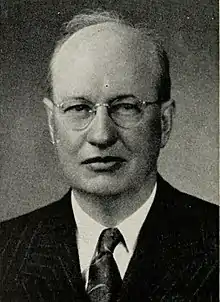Oliver Ellsworth Buckley
Oliver Ellsworth Buckley (August 8, 1887 – December 14, 1959) was an American electrical engineer known for his contributions to the field of submarine telephony.
Oliver Buckley | |
|---|---|
 | |
| Chairman of the President's Science Advisory Committee | |
| In office April 20, 1951 – June 15, 1952 | |
| President | Harry S. Truman |
| Preceded by | Position established |
| Succeeded by | Lee Alvin DuBridge |
| Personal details | |
| Born | August 8, 1887 Sloan, Iowa, U.S. |
| Died | December 14, 1959 (aged 72) Newark, New Jersey, U.S. |
| Education | Grinnell College (BS) Cornell University (MS, PhD) |
| Awards | IEEE Edison Medal (1954) |
Biography
Buckley joined the Bell System after completing his PhD in physics at Cornell University in 1914. In 1915, Oliver Ellsworth Buckley, along with AT&T coworkers H. D. Arnold and Gustav Elmen, developed a method of substantially improving the transmission performance of submarine communications cable so that transmission speed of over 2000 letters per minute were achieved.[1] They constructed the cable by wrapping the copper conductors with annealed permalloy tape, a material that Elmen had discovered, thus inductively loading the cable.
Buckley was the president of Bell Labs from 1940 to 1951, and chairman of the board from 1951 until his retirement in 1952.[2]
Buckley was a member of the General Advisory Committee of the United States Atomic Energy Commission from 1948 to 1954.[3] In that role, Buckley opposed the 1950 decision to proceed with the development of the hydrogen bomb, but by 1952 had changed his view and supported the program.[4]
Buckley received the IEEE Edison Medal for "contributions to the science and art which have made possible a transatlantic telephone cable; for wise leadership of a great industrial laboratory; for outstanding services to the government of his country". The Oliver E. Buckley Condensed Matter Prize is named in his honor.
References
- A. A. Hurdeman, The Worldwide History of Telecommunications, Wiley Interscience (2003), p.314
- Buckley biography by Bell Labs
- "Oliver Buckley: Biography". Institute of Electrical and Electronics Engineers. Retrieved May 27, 2020.
- Bernstein, Barton J. (Fall 1987). "Crossing the Rubicon: A Missed Opportunity to Stop the H-Bomb?". International Security. 14 (2): 147–148.
External links
| Wikimedia Commons has media related to Oliver E. Buckley. |
- IEEE Buckley biography
- Biographical Memoirs from The National Academy of Sciences by Mervin J. Kelly
| Government offices | ||
|---|---|---|
| New office | Chairman of the President's Science Advisory Committee 1951–1952 |
Succeeded by Lee Alvin DuBridge |